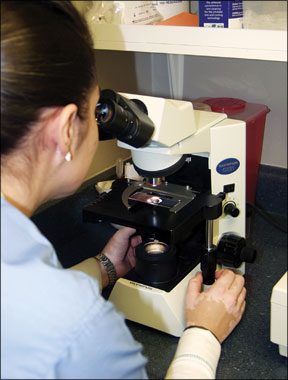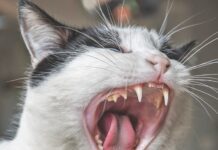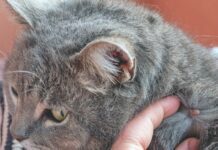Veterinarians generally recommend that all cats undergo a thorough physical examination at least once a year until they have reached seven or eight years of age, and twice annually thereafter as they progress into their senior years. Such a multifaceted exam will include a complete blood count (CBC), a procedure that, thanks to a variety of sophisticated laboratory techniques and equipment, can reveal or at least suggest the presence of many feline health disorders. (See related article in the June 2007 issue of


Bev Caldwell
288
The importance of the CBC should not be underestimated. Among other things, a CBC will determine the concentration of red blood cells (erythrocytes) in a drop or two of blood. The procedure will also reveal the density of hemoglobin, an important constituent of each erythrocyte. If the CBC shows an abnormally low concentration of red blood cells, an insufficient presence of hemoglobin, or both, the veterinarian will probably conclude that the cat is suffering from anemia – a condition characterized chiefly by an inadequate circulation of oxygen through the animals system. While not a disease in itself, anemia is associated with several disease processes.
Anemia is often treatable if its cause or causes can be identified; if undiagnosed, however, this blood disorder can lead to a cats gradual disability and eventual death. A routine CBC will typically cost a cat owner about $50, says Richard Goldstein, DVM, an associate professor of small animal medicine at Cornell Universitys College of Veterinary Medicine. “But its money well spent,” he notes. “Its better financially to spot anemia and to prevent it, if possible, from getting worse than it is to try to deal with it after it has progressed.”
Oxygen Deficit
Erythrocytes are concave, disk-shaped cells whose red color is imparted by hemoglobin, an iron-containing pigment that fills the red blood cells. Both erythrocytes and hemoglobin are produced in the bone marrow in response to stimulation by a hormone called erythropoietin, which is produced primarily in the kidneys. In a normal cat, this hormone stimulates the production of erythrocytes in response to the need for oxygen. When a cat inhales, the oxygen binds with the hemoglobin and is transported to all the cells of the body.
Because oxygen and other substances, such as iron (which red blood cells transport as part of the hemoglobin molecule), are necessary to support the life of any animal, a severe loss or destruction of red cells or a dramatic reduction in the ability of the bone marrow to produce new erythrocytes presents a severe health threat. Veterinarians generally recognize two forms of anemia – regenerative and nonregenerative.
Regenerative anemia results from acute or chronic bleeding or destruction within the cats body. In some cases – a deep wound, for example – the blood loss will be obvious. But in cases that involve destruction of red blood cells, gastrointestinal bleeding, or infection with blood-sucking external or internal parasites, the signs of blood loss and anemia may go unnoticed for an extended period. Regenerative anemia can also result from an animals ingestion of certain chemicals, such as acetaminophen or the ingredients in naphthalene mothballs. Fortunately, this type of anemia can often be successfully treated by eliminating the underlying cause and administering blood transfusions.
The outlook for nonregenerative anemia is less hopeful. This form of anemia develops because the bone marrow is not producing new cells rapidly enough to replace old cells that have become destroyed or otherwise dysfunctional. Common causative factors include infection with feline leukemia virus (FeLV), which severely represses bone marrow function, and cancer of the bone marrow, which overwhelms the tissue responsible for producing red blood cells and renders it nonfunctional. Nonregenerative anemia can also be caused by medications that depress bone marrow function; in cats, these drugs include antibiotics such as sulfa drugs and chloramphenicol.
Clinical Signs
In the early stages of anemia, says Dr. Goldstein, a cat may show few if any indications that it is harboring the disorder. “Cats are very good at concealing the signs,” he notes, “until the condition becomes quite severe. By the time the owner notices changes in an animals behavior or appearance, it can be an emergency situation.” The clinical signs include apparent weakness, a reluctance to exercise and rapid respiration (because, Dr. Goldstein points out, “The cat is trying to increase the amount of oxygen that is getting into its blood”). Of all signs, he says, the most clearcut is paleness of the mucous membranes – especially the gums, which may become almost white in color.
In addition, an anemic cat may have an irregular heartbeat, diminished appetite and weight loss. Some animals may appear to be nauseated and may pass blood in their urine or feces.
Treating Anemia
A veterinarian can usually arrive at a diagnosis of anemia based on the CBC and the patients behavior and physical appearance – especially the noticeably pale gums and other mucous membranes. Treatment options will vary according to the cause of the disorder. In acute cases of anemia stemming from blood loss and red blood cell destruction, blood transfusions can save an affected cats life and thus buy time until the cause of the anemia is determined.
“A blood transfusion,” says Dr. Goldstein, “is an immediate measure to get the animal through the crisis. If the blood loss is a result of trauma, then a transfusion, accompanied by fluid therapy, may suffice. It will replenish the cats system until the regeneration of the natural blood supply starts to occur. But if red cell destruction is present, the next stage of treatment will depend on the cause. If the cause is an infectious disease, for example, we may treat the animal with antibiotics. If we determine that an exaggerated immune response is causing the problem, we may try to suppress the immune system.”
Unfortunately, inadequate erythrocyte production caused by FeLV infection cannot be significantly reversed. Thus, this type of anemia has at present a poor prognosis, although a cats life may in some instances be extended with periodic blood transfusions and treatment for other illnesses resulting from the infection. Overall, says Dr. Goldstein, “The prognosis is good for feline anemia caused by infection, but its much less good for anemia resulting from FeLV and from cancer.”
Lowering the Risk
Although some veterinarians may recommend supplementing a cats diet with iron as a means of encouraging the development of red blood cells, Dr. Goldstein contends that dietary habits are, for the most part, inconsequential in lowering the risk of feline anemia. “Cats dont often get an iron deficiency from a lack of iron in their diets,” he says. “And for cats that have already been diagnosed with anemia, we would like to see their cells regenerate while theyre on a normal commercial diet.” He does, on the other hand, note one link between dietary intake and anemia; feeding cats human food that contains garlic and onion powder has been associated with the development of feline anemia.
To lower the risk, he advises owners as follows: “Keep your animal indoors to minimize its chances of being bitten by an FeLV-infected cat. Keep up with all of the vaccination protocols. Dont let the cat come in contact with toxins such as acetaminophen. Get to know what your cats healthy gums normally look like and let your veterinarian know if they suddenly start looking white or pale. And be sure to take the animal in for a physical checkup and blood count annually or semiannually.”
v


